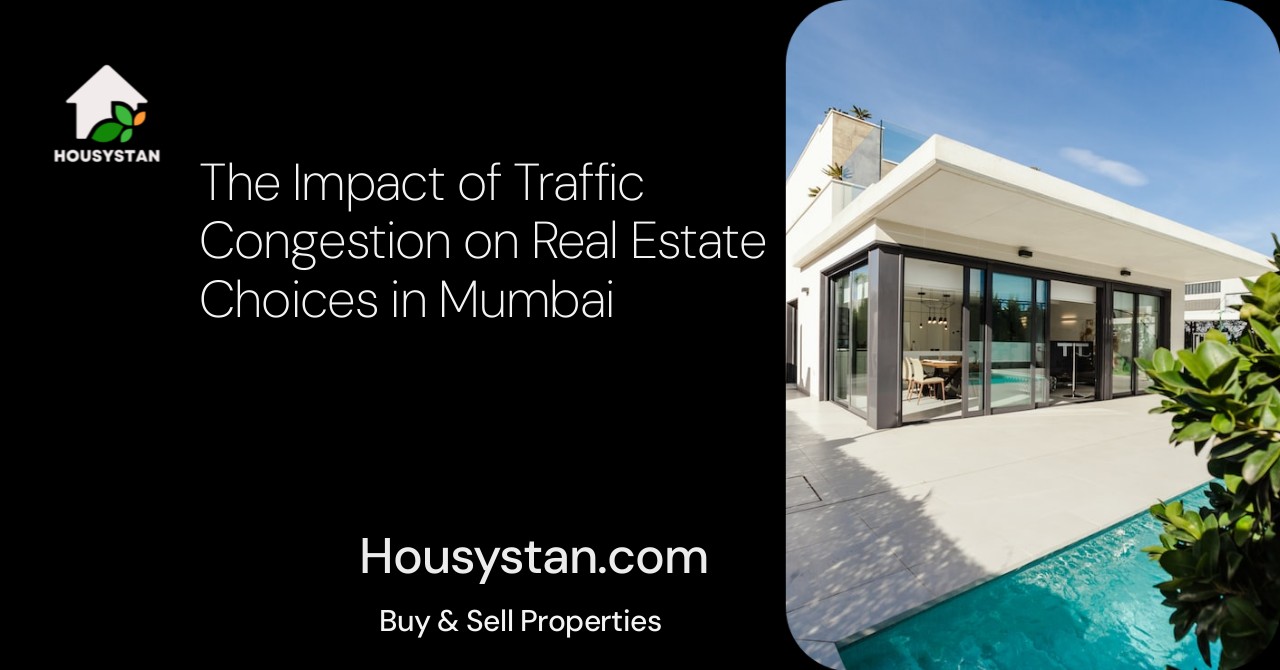The Impact of Traffic Congestion on Real Estate Choices in Mumbai
Read latest blogs and articles from Housystan

The Information mentioned here was last updated on:
27/11/2025The Impact of Traffic Congestion on Real Estate Choices in Mumbai
Mumbai, India’s bustling financial hub, is known for its vibrant culture, diverse population, and unmatched opportunities. However, one aspect of life in Mumbai that residents and visitors can all agree is a challenge is the city's notorious traffic congestion. The relentless jams and gridlocks have a significant impact on daily life and particularly influence real estate choices across the city. Let's explore how and why traffic congestion shapes real estate decisions in Mumbai, offering insights into this urban phenomenon.
The Reality of Mumbai’s Traffic
- Verified Tenants/Buyers
- Unlimited Property Listing
- Zero subscription/charges fee
Mumbai's traffic congestion is a result of several factors — a dense population, a high number of vehicles, and an infrastructure struggling to keep pace with the city’s growth. According to recent studies, Mumbai consistently ranks among the top cities in the world for traffic congestion, with commuters spending hours stuck in traffic during peak hours. This congestion not only causes frustration and stress but also significantly affects the quality of life, prompting many to reconsider their priorities when choosing where to live or invest in real estate.
Proximity to Work: A Major Consideration
For many Mumbaikars, one of the most important factors when choosing a place to live is proximity to the workplace. Given the city’s severe traffic issues, even short distances can take a long time to traverse. Therefore, areas closer to business districts like Nariman Point, Bandra-Kurla Complex, and Lower Parel are in high demand. Residents in these areas can save considerable time on their daily commute, leading many to prioritize these locations despite the premium price tags.
The Rise of Integrated Townships
As the battle with traffic shows no signs of waning, there’s a growing trend towards integrated townships. These are self-sufficient neighborhoods offering residential units, offices, schools, shopping, healthcare, and recreational facilities — all within walking distance. By reducing the need for daily long-distance commutes, these townships are becoming increasingly attractive. Developers have taken note and are focusing efforts on creating more of these integrated living spaces to cater to the city’s growing population.
Public Transport Accessibility
While owning a vehicle is common in Mumbai, the city’s public transportation system, including suburban trains, buses, and the metro, remains a lifeline for many. Properties with good access to these modes of transport are highly sought after. Being near a train station or metro line can significantly cut down commute times and reduce dependency on road travel, sparing residents from the brunt of road traffic. Consequently, areas with robust public transport connectivity often witness a surge in real estate demand.
Suburban Migration
With soaring real estate prices in the city center and the increasing pressures of traffic congestion, many are choosing to move to Mumbai’s suburbs. Suburbs like Thane, Navi Mumbai, and Borivali are gaining popularity as they offer more affordable housing options and a slightly slower pace of life compared to the bustling city center. While the daily commute might be longer, many find the trade-off worth it for larger living spaces and better air quality. Moreover, ongoing infrastructure projects promise improved connectivity between these suburbs and the main city, making suburban living a more viable option.
Work-from-Home Impact
The global shift towards remote work, accelerated by the pandemic, has also influenced real estate choices and traffic patterns in Mumbai. With more companies adopting flexible working arrangements, the necessity of living close to work has somewhat decreased. This change has permitted many to explore real estate options further afield, where they can find more affordable, larger homes without the pressure of battling daily traffic congestion.
The Role of Infrastructure Development
To combat traffic congestion, extensive infrastructure development is underway in Mumbai. Projects like the Coastal Road, Metro expansions, and trans-harbor links aim to streamline traffic flow and reduce travel times. Areas under development or close to these new infrastructure projects often experience a real estate boom as buyers anticipate improved commutes and increased property values in the near future.
Green Spaces and Quality of Life
As traffic and commuting take a toll on daily life, the desire for improved quality of life grows stronger. Access to green spaces, parks, and recreational areas becomes an appealing factor for those choosing where to live. In a city where time spent in traffic can detract from personal and family time, living in a place that offers a respite from the urban chaos is highly desirable. This has led to an increased demand for real estate developments that incorporate green spaces and community-oriented designs.
Impact on Commercial Real Estate
It isn't just residential real estate that's affected by traffic; commercial real estate in Mumbai faces similar influences. Businesses are strategically choosing office locations based on ease of access for employees, proximity to public transport, and other factors that can mitigate travel stress. Consequently, areas offering these conveniences often become commercial hotspots, driving up demand and rental values.
Conclusion: A Continuous Flow of Influence
In conclusion, traffic congestion in Mumbai wields a continuous, significant influence on real estate decisions. It's a factor that developers, buyers, and renters cannot ignore, shaping the city’s landscape in manifold ways. From pushing demand for integrated townships and suburban living to influencing commercial real estate and pushing infrastructure development, the patterns reflect a complex, ongoing interaction between human behavior, urban planning, and economic forces. Understanding these dynamics offers a window into the present and future of one of the world’s most dynamic cities.